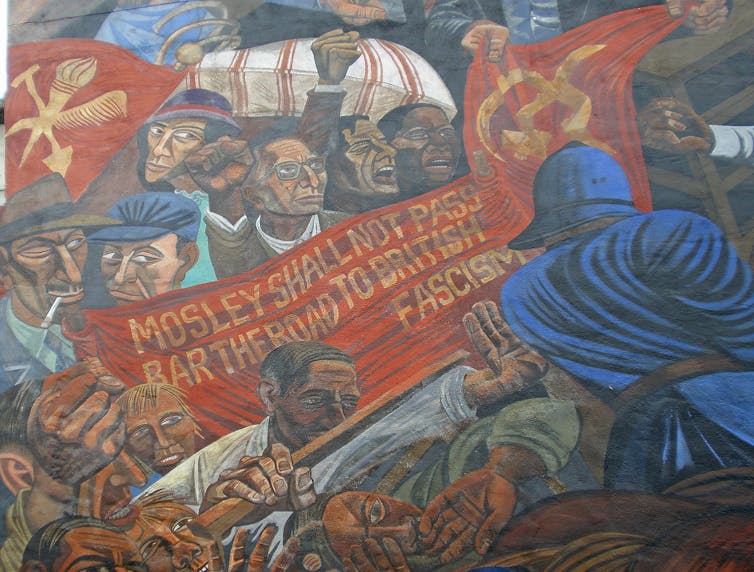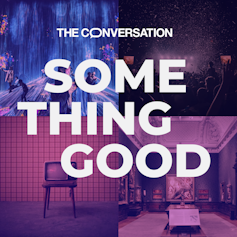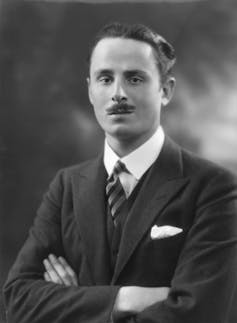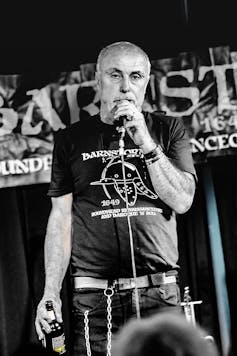
In the 1980s, Britain’s far right was on the rise. Fascist parties fielded over 100 candidates in the 1983 general election. And culturally, the far right was also making ground.
“White power” bands like Skrewdriver and Peter and the Wolf began drawing sizeable crowds and selling thousands of records. In 1987, Skrewdriver’s frontman founded Blood & Honour, a music network that soon gained followers and branches throughout the US and Europe.
Blood & Honour’s emergence caused tremors among the UK antifascist movement. Anti-Fascist Action (AFA), the dominant antifascist group of the time, struck back with their own musical network: Cable Street Beat (CSB).
This is the story of how music became a battleground in the 1980s and 1990s, as antifascists fought fascism with guitars and microphones.
Cable Street Beat
Cable Street Beat was named after the antifascists’ celebrated victory over Oswald Mosley’s Blackshirts. Before the second world war, British MP Oswald Mosley had commanded a growing fascist movement that had been fiercely resisted by antifascists.
On October 4 1936, Mosley amassed his Blackshirts on Cable Street to march through the East End of London. However, around 100,000 militant antifascists gathered to oppose them, ultimately preventing the fascists’ march.
The first CSB gig was held on October 8 1988 at the Electric Ballroom in London. Newtown Neurotics, The Men They Couldn’t Hang and punk poet Attila the Stockbroker electrified a 1,000-strong crowd.
Crucially, the audience also heard a powerful speech from Solly Kaye, an antifascist veteran of the actual Battle of Cable Street five decades earlier. Kaye warned the assembled concertgoers that fascist “songs” were “poison put into the minds of young people”.
Brendan, an AFA and CSB organiser and horn player with antifascist punk band the Blaggers, described to me how CSB was needed: “Firstly as a way to draw people who might be attracted to the far right into a more progressive type of politics … Secondly it was needed to bring people together from different cultures. Thirdly, just to stick two fingers up to the far right.”
The power of punk
CSB drew energy from the UK’s frenetic punk scene. Bands such as the Angelic Upstarts, Snuff and Yr Anhrefn all enthusiastically took up CSB’s cause. They shared the stage with antifascist activists who gave rousing speeches.
Punk, and in particular the working-class focused, aggressive Oi! subgenre and related skinhead subculture, was an area that the far right had long tried to colonise.
Blood & Honour wanted to believe otherwise, but the skinhead movement (which originated in the 1960s) had roots in Jamaican culture and reggae. Indeed, few skinheads had any interest in white power.
“If far-right politics helped inform the identity of some within the … skinhead subculture,” says historian Matthew Worley, “then the vast majority resisted and rejected the substance of the fascist message.”
CSB gained considerable ground in this battle. High-profile bands like The Specials and The Selecter played benefit gigs. Multiple other bands – including The Oppressed, Knucklehead and Spy Vs Spy – put out AFA fundraising CDs.
Thomas “Mensi” Mensforth, the charismatic lead singer of the Angelic Upstarts’ (who sadly passed away in 2021), even narrated an AFA documentary produced for the BBC in 1993.
Unity Carnivals
CSB’s most high-profile strategy was its Unity Carnivals. The first, held in Hackney Downs Park in 1991, attracted 10,000 attendees. This made it the biggest public antifascist event in a decade. Bands including Gary Clail’s On U Sound System, The 25th of May and The Blaggers kept the vast crowds dancing all day under the banner of antifascism.
But the partying was punctuated with serious political rhetoric. Throughout the day activists gave speeches and handed out flyers. Brendan was part of the team that organised the carnival.
“It’s a cliché,” he told me, “but that carnival really did unite people. It brought a really diverse crowd together in Hackney and really got the political messages across.”
Two more carnivals followed: another in Hackney in 1992 and one in Newcastle in 1993, where The Shamen headlined with their chart-topping song Ebeneezer Goode.
Freedom of movement
CSB was wound down in the early 1990s. Nevertheless, music remained a central element of AFA’s activism.
By the early 1990s, electronic dance music had taken off in the UK. Antifascists immediately saw the potential and in Manchester local DJs and AFA set up the Freedom of Movement campaign in 1993 to mobilise these ravers. AFA’s magazine, Fighting Talk, declared Freedom of Movement’s aim was to “politicise the previously apathetic dance club scene, raising issues of racism and fascism”.
From 1993 to 1996, AFA put on a series of antifascist club nights in cities from Edinburgh to London. They also released an AFA benefit album, This is Fascism, featuring prominent DJs and producers including Carl Cox, Drum Club and Fun-Da-Mental.
Fascism is on the march again. The far right in Italy, Argentina and the Netherlands have all recently experienced electoral victories. Many other countries – such as the US, Brazil and India – have experienced explosions in far-right activity.
Findings from my own research and others’ demonstrate that fascists are adept at using culture to achieve their goals. It enables them to transmit their hateful ideology, generate money and forge networks across countries.
But the successes of CSB and AFA provide us with valuable lessons. Music can send a powerful message and mobilise hundreds of thousands to resist racism. Its emotive nature can change listeners’ worldviews, and help create a shared culture that is antithetical to the far right’s divisive goals.
This is an area where antifascists can make real gains against their foes: uniting antifascism and music is a tried-and-tested method for winning over the hearts and minds of people against hatred.

Looking for something good? Cut through the noise with a carefully curated selection of the latest releases, live events and exhibitions, straight to your inbox every fortnight, on Fridays. Sign up here.![]()
Alexander Carter, Research Fellow, University of Birmingham
This article is republished from The Conversation under a Creative Commons license. Read the original article.


Comments